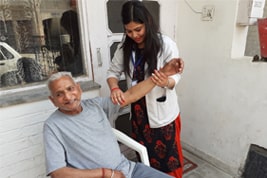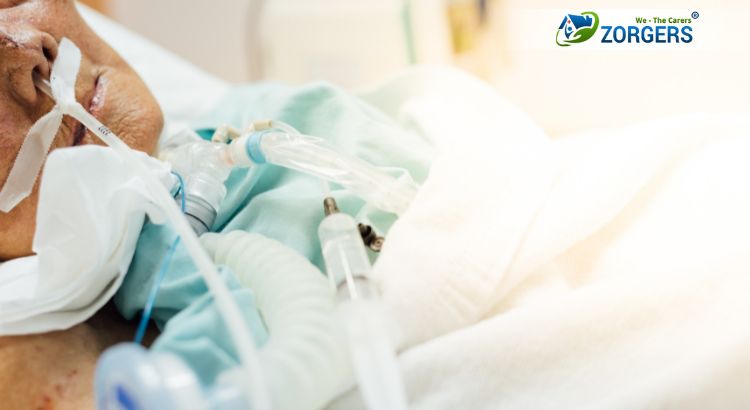What is tracheostomy?
A tracheostomy is an opening/hole through the neck into the windpipe. Tracheostomy is done to aid the patient in breathing which has developed complications in breathing through the nose (and even mouth) because of various reasons explained. The need for tracheostomy decides its duration if it can be weaned off or not.
Tracheostomy is done via a surgical procedure, usually by a team of doctors, in which a tube is inserted via a cut placed in the neck just below the vocal cords. It allows air to enter the lungs and hence breathing occurs via tube instead of the mouth, nose, and throat.
Why is there a need for tracheostomy and who requires it the most?
A tracheostomy is mainly done with the sole purpose of ensuring proper air to lungs which we all understand is a must. There are many reasons due to which the airflow to the lungs can get impacted. Tracheostomy is done with an intent:
– To bypass an obstructed airway in the upper region
– To clean or even remove any secretions in the airway
– To deliver oxygen to the lungs with ease and safely manner
Obstruction of air to the lungs can be caused because of any of the following reasons:
– Laryngectomy
– Epiglottitis
– Burn or severe allergic reaction (anaphylaxis) that causes the throat to become swollen and narrowed
– Vocal cord paralysis
– Tumors like cystic hygroma
– Severe neck and mouth injuries
– Obstructive sleep apnea
– Airway protection post any head or neck surgery; like in case of laryngeal surgery
– Prolonged mechanical ventilation via machine
– Cancer in and around the face and neck.
– Congenital abnormalities involving airway since birth
A person with any lung problem might also require a tracheostomy procedure to enable proper breathing. Those lung problems might include:
– Any chest injury during an accident or a fall
– Chronic obstructive pulmonary disease (COPD) for a reduction in teas space anatomically
– Needing prolong respiratory support in conditions like bronchopulmonary dysplasia (BPD)
Why is tracheostomy a critical procedure
Several tracheostomies are done every year and at times. But still, tracheostomy is critical because of its very aim to ensure proper air to lungs. If proper tracheostomy care is not received by the patient, it will lead to serious complications.
Yes, complications can be a part of every surgical procedure. But in this case, it can be life-threatening within a few minutes and mostly can be resolved only by a specialist. If proper instructions are not followed or even if some disease appears suddenly, it may complicate the prevailing situation.
Following complications can appear anytime in the later stages of tracheostomy and requires proper training to take care of the situation:
– Acute airway obstruction
– Blocking of tube including mucous plugging or occluded cannula
– Aspiration
– Tracheal trauma or even infection at the hole
– Tracheal stenosis
– Dislodging of the tube
Patient care with a tracheostomy requires patience and time for continuous monitoring, along with skillsets. And missing any one of those might lead to a fatal situation for the patient.
How is tracheostomy done?
This surgical procedure is done in an operating room of the hospital equipped with all amenities and professional qualified staff and doctors. The patient is monitored continuously for oxygen saturation via pulse oximeter and cardiac rhythm or EKG is also kept under check. Anesthesia is provided to the patient mainly including both intravenous medication and local anesthesia as well as to make the patient comfortable and feel no pain.
An opening or cut is made into the tracheal anterior wall, mainly via the second-to-third or the third-to-fourth tracheal rings. Followed by the insertion of tracheostomy for keeping the hole patent and tube is secured with sutures or tracheostomy collar or even by both in some cases.
Tracheostomy care at-home:
Almost all hospitals have special wards for routine care of the patients with tracheostomies. A team of nurses handling such wards is specially trained to handle all complications related to tracheostomy. It’s advisable to stay in the hospital immediately after the surgical procedure as per your doctor’s advice.
Post the initial healing in the hospital, a patient with tracheostomy can be shifted to home for further recovery. But before this is done, the family must ensure that they are prepared to deal with any complications related to tracheostomy and otherwise. Be aware that complication like blocked or displaced tracheostomy tubes needs professional training as well as care.
However, these days a family member can also get trained for post tracheostomy care of the patient. Some hospitals provide necessary training to the caretaker of the patient from the family. Nurses generally provide care assistance for temporary tracheostomy patients within the hospital but for permanent ones educating and trying about managing the airway independently in certain situations becomes a must. Either a patient or a family member involved in the patient’s care can go through that training.
Similarly, specialist tracheostomy nurses are also available nowadays for the at-home care of the patient. This minimizes the risk of handling the patient by family members themselves due to a lack of knowledge and techniques in handling the patient with tracheostomy.
A few important points one must consider before thinking about tracheostomy care at home:
– A patient may take initially three to four days to adapt to breathing via a tracheostomy tube.
– Talking and making some sounds can also take little learning and practicing tricks like for some covering the tube helps during talking, etc.
– Immediately after the procedure surgeons will monitor the condition for a few days for proper healing. Once discharged appointments might still be scheduled for check-ups at regular intervals and for replacing the tube with a new one initially after 10 to 15 days and further ones can be managed by a staff nurse or trained person.
– If the tracheostomy tube is placed for the long term, then the family will be instructed to follow a proper home care treatment. It might include suctioning of the trachea, cleaning insertion, or changing the tube. Home healthcare can also be taken up for the same for better home care by a professionally trained person for tracheotomy cases.
– Take a complete manual including percutaneous guide wires is provided usually in the emergency tracheostomy box and it must always be kept at the bedside for help in an emergency.
– The patient’s airway needs close monitoring of 24×7 to avoid any fatal outcome. A tracheostomy care chart is also used by some healthcare professionals to record the care regime and status.
What a person must know after going home with a tracheostomy procedure?
A few things to keep in mind while moving the patient to home with tracheostomy still on:
– Keep the number of emergency services like ambulance, treating doctor/hospital noted and easily accessible for the patient’s attendant.
– Immediately after the procedure, the patient should communicate with others using a writing method; unless the doctor provides any special instructions.
– The outer canal must not be removed unless instructed by the doctor.
– Using tracheostomy cover is the best way to protect the airway from every outside elements like dust particles, cold air, or a simple breeze, etc.
– In case of any doubt or concern, the doctor must be directly contacted without any delay.
Takeaway:
Tracheostomy care is a must to avoid any sort of fatal outcomes or complications in the later stages. Appropriate care post tracheostomy becomes mandatory in cases of permanent intubations with no weaning off. A bedside manual and some education about dealing with emergency situations are provided to the patients to keep them safe.
Nowadays at-home care services are also an easy option to take care of the patient 24 hours a day post tracheostomy. Hiring a home care service is easy and readily available online with several customizable options regarding hours and days for which care is required.
Tracheostomy might require some additional care as per the age group of the patient and disease condition. But general points to take care of the patient post tracheostomy during at-home care include:
– Following sterile technique like washing hands, wearing gloves, and using a new tracheostomy tube while changing it.
– Following a clean technique including washing hands and properly cleaning the trash tube before re-using it. But no tube can be reused if it is soiled or wet.
The home environment is usually clean and hence lesser chances for contact with a sick person. Following proper measures can prevent any sort of infection and complications related to tracheostomy. Proper precautions and guidelines must be followed during tracheostomy care to avoid any sort of fatal situation. Even opting for a professional at-home nursing care service for a tracheostomy patient can ensure proper care as per norms.
If proper instructions are applied, then even long-term tracheostomy patient can survive with ease at-home.
References:
https://my.clevelandclinic.org/health/treatments/17568-tracheostomy-care
https://www.rch.org.au/rchcpg/hospital_clinical_guideline_index/Tracheostomy_management/
https://www.healthline.com/health/tracheostomy#uses






Thanking you for sharing the great information’s. This was an useful blog for Care Coimbatore is one of the leading primary health care service center providers in and around Coimbatore, based on measures of patient safety, quality, cost, patient satisfaction and staff engagement
Mais India are the Endotracheal Tube Manufacturer. Please visit us – https://www.maisindia.com/endotracheal-tube
This Blog Is Very Helpful And Informative For This Particular Topic. I Appreciate Your Effort That Has Been Taken To Write This Blog For Us. Tracheostomy care at home, nursing care of tracheostomy patient, tracheostomy patient care, care of patient with tracheostomy, tracheostomy stoma care, trach suctioning nursing, care of tracheostomy nursing. physiotherapy in hyderabad